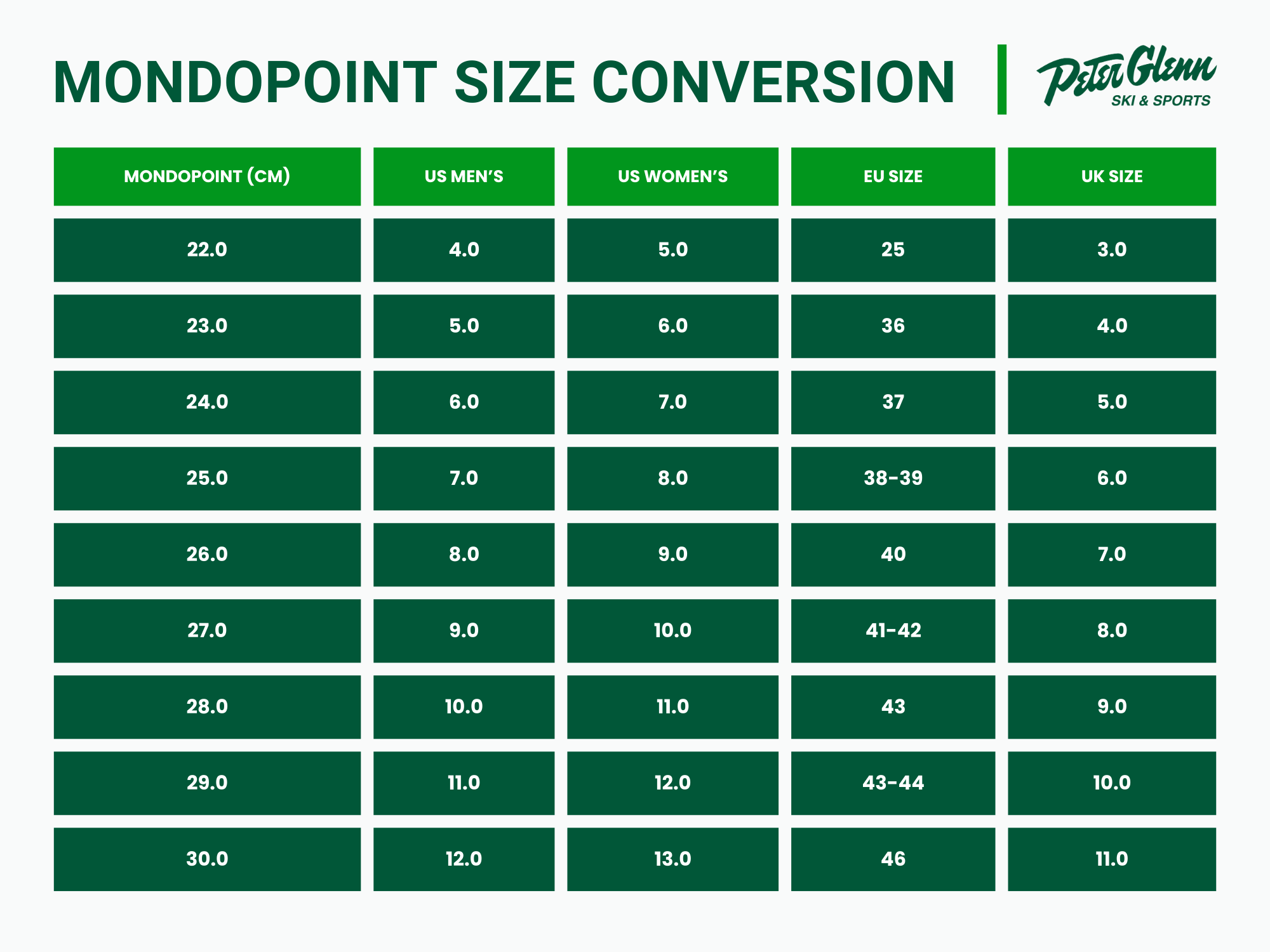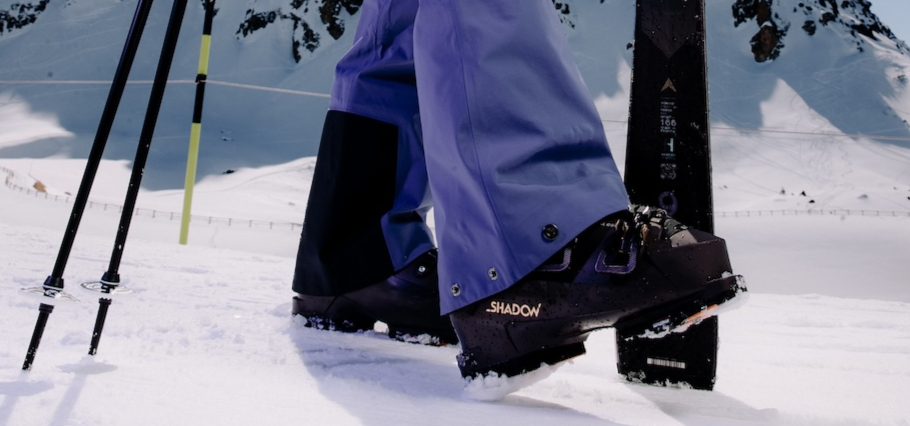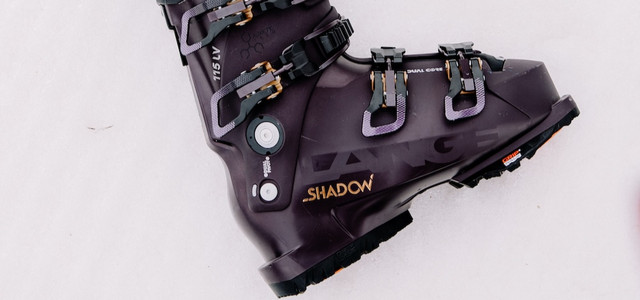Ski Boot Size Chart: Understanding Mondopoint Sizing
Posted by Peter Glenn Staff on Sep 22nd 2025
Table of Contents
The Short Answer: Ski boots use the Mondopoint sizing system based on foot length in centimeters. Finding the right ski boot size means matching your foot measurements to the correct Mondopoint size, which gives you better control and comfort on the slopes.
Unlike regular shoes, ski boots require precise sizing that directly affects your skiing performance. A boot that's too loose can cause a dangerous heel lift while skiing, and one that's too tight can lead to cold feet and discomfort. That's why boots use Mondopoint: a measurement system based on your exact foot length in centimeters.
All About Mondopoint Sizing
What is Mondopoint?
Mondopoint is the universal measurement system used for ski boots worldwide. Unlike regular shoe sizes that vary by region and manufacturer, the mondopoint size measures your foot length in centimeters, providing consistent sizing across all boots. For example, if your foot measures 26.5 centimeters, your mondo size is 26.5.
This system differs from standard shoe size measurements because it's based on actual foot measurements rather than arbitrary size numbers. While you might wear a US size 9 shoe, your mondopoint size gives you a precise measurement that matches directly to ski boot sizes.
Size Categories
Ski boots come in two main components: the outer boot shell and the inner liner. The boot size is measured in whole numbers (like 26, 27, 28), while liners can be adjusted to create half sizes through varying thickness.
Performance fit and comfort fit represent two different approaches to ski boot fit:
- Performance Fit: This means choosing boots that fit very snug, with toes lightly touching the front when standing straight. Your toes should pull back slightly when in skiing position. Advanced skiers often prefer this snug fit for better control.
- Comfort Fit: Designed with a bit more room, particularly in the toe box. Beginners and intermediate skiers usually choose this option for longer comfort on the slopes.
Your skiing level affects which fit you should choose. Beginners benefit from comfort fit as they learn proper technique. Intermediate skiers might start transitioning to a performance fit as their skills improve. Advanced skiers typically use a performance fit for maximum control and response.
Measuring Your Feet for Ski Boot Size
Step-by-Step Guide
Getting an accurate foot measurement for your ski boot size is simple with the right tools and approach.
Here's how to do it:
Required Materials
- Blank piece of paper (larger than your foot)
- Pencil or pen
- Ruler or measuring tape
- Ski socks
Measurement Process
- Put on your ski socks before measuring
- Place the paper against a wall
- Stand on the paper with your heel touching the wall
- Mark the longest point of your foot (usually your big toe)
- Measure from the wall to the mark in centimeters
- Repeat with your other foot
Common Measurement Mistakes
When to Measure
Measure your feet in the afternoon or evening when they're slightly larger from daily activities. This helps prevent choosing boots that feel too tight after a long day of skiing.
Using the Right Socks
Wear proper ski socks during measurement - not regular athletic socks. Ski socks are thinner and more form-fitting, giving you the most accurate measurement for boot sizing.
Both Feet Considerations
Always measure both feet and use the longer measurement when selecting your mondopoint size. Most people have one foot slightly larger than the other, and you'll want your ski boots to fit comfortably on both feet.
Width Measurements
For width, measure the widest part of your foot while standing. If you have a wider foot, look for boot models specifically designed for wider feet. This measurement helps determine if you need a regular or wide ski boot model.
Remember to stand naturally while measuring - your weight should be evenly distributed, and your toes should be relaxed, not gripping. This gives you the most accurate measurement for finding a performance fit that works properly on the slopes.
Ski Boot Size Charts and Conversions
Mondopoint Size Conversion Chart

Performance Fit vs. Comfort Boot Guidelines

Width Considerations
Ski boots come in different width measurements called "lasts":
- Narrow: 97-98mm
- Medium: 99-101mm
- Wide: 102mm+
Shell Size Information
- Boot sizes typically come in whole numbers only
- Half sizes are created through liner thickness
- A proper ski boot fit allows about one finger width behind the heel when toes touch front
- Liners will pack out 3-5mm after break-in period
- Heat-moldable liners can provide custom fit within shell volume
Remember that boot size accuracy affects both comfort and performance. When in doubt, work with a qualified bootfitter who can assess your specific foot shape and skiing style.

Find Your Perfect Boot Fit with Peter Glenn
A properly fitting ski boot should hold your heel firmly in place while allowing your toes to wiggle slightly. When you flex forward into skiing position, your toes should barely brush the front of the boot. A performance fit means no pressure points or pinching around the ankle or forefoot.
New boots typically need a few days of skiing to break in, during which the liner will mold to your foot shape. Don't be alarmed if they feel extra snug fit at first - this is normal. Check your ski boot size carefully - size down if you feel your heel lifting when you walk or ski, as this indicates the boot is too large.
Peter Glenn's experts can help you find the right boot size and model for your foot shape. They'll assess your skiing ability and foot characteristics to recommend boots that match your needs. Shop in store or online to find your perfect ski boot with our expert bootfitters.



